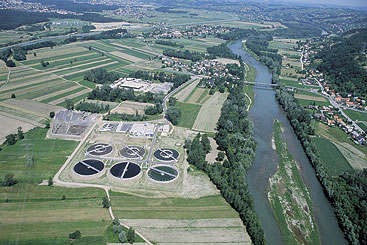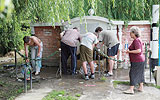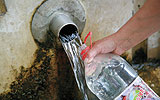The ICPDR Joint Action Programme
ICPDR Danube Watch: Ecotourism boost in Danube-Drava National Park

The ICPDR Joint Action Programme
The report on the Joint Action Programme summarises achievements realised through the work of the countries under the ICPDR. This analysis identifies the challenges that remain in order to implement the Joint Programme of Measures.

Most improvements in water quality are due to the impact of the investment programme of the water industry and pollution control measures, which have dealt with many point sources of pollution such as sewage systems, wastewater treatment plants, industrial sites and agricultural units.
In 2000, the ICPDR developed the first Joint Action Programme (JAP) for the period 2001–2005. The JAP focused on pollution from point and diffuse sources, wetland and floodplain restoration, reduction and control of priority substances, water quality standards, prevention of accidental pollution, flood control and river basin management. Attention was given to both structural investments and non-structural measures like policy reforms measures with the overall goal to enlarge nutrient reduction and to improve protection of transboundary waters and ecosystems.
Introducing policies and legal instruments. One conclusion that can be drawn from a review of the JAP is that commitment to EU directives is central to success and this commitment must be fostered throughout WFD implementation. Danube countries faced substantial challenges in establishing and strengthening the policy and institutional framework required for functioning market-based and democratic societies. Today, progress can be reported with all Danube countries in redesigning policies, programs and regulations, in establishing appropriate incentive structures, redefining partnerships with stakeholders and strengthening financial sustainability of environmental services. Still, the key policy challenge Danube countries face is to identify the most effective ways of implementing EU environmental directives.
“The Joint Action Programme can be seen as the ICPDR’s first touchstone whether a joint formulation and agreement on measures inside a wide framework would be possible and whether these measures would be implemented in time”, says Richard Stadler, Head of the Austrian Delegation to the ICPDR.


Providing safe and clean water for people and nature is one of the goals of the ICPDR.
Improving institutional tools. Several significant changes in the water sector, in the regional water management and its social and economic implications have considerably improved institutional and intergovernmental coordination in the Danube Basin. State control has been replaced with the distribution of responsibilities and greater levels of autonomy at regional and local levels. This has made it necessary to develop new and more complex networks of partnerships and has increased the numbers and variety of players involved in water management.
Most Danube countries have functional institutional administrative structures at the central and regional or local level with clear responsibilities. Inter-ministerial structures exist at the national level, which assures coherence within sectors and complements the application of laws and regulations. Investigations show that there is a need for changes or amendments to make institutions in some of the Danube countries more efficient and to avoid duplication of mandates and responsibilities in relation to water management and pollution control.
Meeting challenges at the local level. There is an increasing tendency of the local authorities in the Danube countries to take more responsibility in environmental and water management strategies, due to their increasing role in national policy. Additionally, local water policies will have to consider the transboundary nature of the border rivers and the need to take measures and decisions together with the neighbouring communities at different levels by implementing solutions at the local or regional level wherever possible.
Still, the role of environmental authorities in most of the Danube countries at the local level needs to be strengthened by integrating environmental considerations into economic development. There are areas where the absence of adequate policy instruments and institutional capacity to support the monitoring of water use leads to increased service costs and the eventual deterioration of the resource and supporting service infrastructure.
Investment projects throughout the basin. There has been a considerable improvement in water quality of the Danube Rivers since 1995. Annual reductions of more than 290,000 tons of BOD, nearly 45,000 tons of total Nitrogen, and approximately 18,000 tons of total Phosphorus are estimated. Improvements in water quality since 1995 are largely attributable to the impact of the investment programme of the water industry and pollution control measures, which have dealt with many point sources of pollution such as sewage systems, wastewater treatment plants, industrial sites and agricultural units.
There are a total of 224 municipal wastewater sector
projects serving a combined total of nearly 22
million inhabitants in 11 Danube Basin countries.
Of the 224 projects, 86 are fully financed and have
either been completed or are
under implementation. The
combined investment cost
of the 84 fully financed projects
is approx. 2,268 MEUR,
which represents approximately
half of the total.
Most of the investment in the wastewater sector
has been realised in the countries that joined the
EU in 2004: the Czech Republic, Hungary, the Slovak Republic and Slovenia. A large proportion
of project financing for these investments was realised
from local and national sources. Significant
progress has been made in Romania since the last
DABLAS update in 2004, and Bulgaria and Croatia
have increased project preparatory efforts but still
lack financing. Limited development in the wastewater
sector has been achieved in the downstream,
non-EU countries, including Bosnia and Herzegovina,
Serbia, Moldova and Ukraine.

Success in the Danube Basin is a result of all countries working together. “The positive network created by all Danube states helps the single Danube state to overcome difficulties and constraints”, says Richard Stadler, Head of the Austrian Delegation to the ICPDR.
International financing has been instrumental behind the development of the municipal wastewater sector in the Danube River Basin. EU grant financing has played a large role in funding several projects throughout the EU countries. The EBRD and EIB have extended loans to municipalities for many of these projects, to help cover the co-financing requirements. The World Bank-GEF Investment Fund has also participated in municipal wastewater projects, in addition to agricultural reform and other nutrient reduction efforts.
Since 1992 the European Community
(PHARE and TACIS
programmes) and the UNDP/
GEF (Danube Pollution Reduction
Program1997 to 1999)
have supported the efforts of
the Danube countries to develop the necessary mechanisms
for effective implementation of the DRPC.
Supporting the basin countries in the reduction of
nutrient loads into the Black
Sea is the objective of the
Strategic Partnership and a
priority. GEF will have invested
$97.5 million in the
Danube Basin by 2006.
The presence of the European Union, as a contracting party to the Danube Convention and an observer to the Black Sea Convention, helps guarantee success by tying concrete environmental achievements directly to the benefits of EU membership. Large infrastructure investment requirements, in particular in the water and sanitation, are essential if the countries are to meet EU standards. Overcoming these financial needs is a huge challenge for some lower Danube countries that have rather limited financial resources for investment expenditure as compared to upper and middle Danube countries.
“The far-reaching successes the Danube countries had achieved during the six years of its duration have proved that the ICPDR has become a strong carrier of achievements”, says Stadler. “The positive network created by all Danube states helps the single Danube state to overcome difficulties and constraints.”





